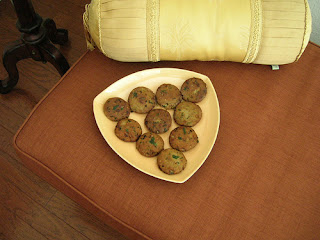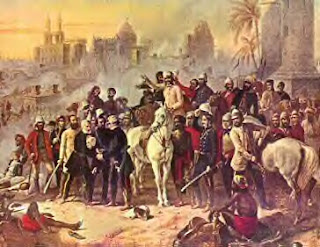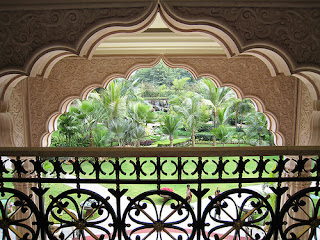 dotted the area opposite Clarks Awadh hotel in the heart of Lucknow's shopping district. With my biryani, I would order a different kabab every night. Along with the usual tandoori chicken and sheek kababs, I remember the subtle flavors of well-made shammi kababs and the tender portions of mutton boti kabab.
dotted the area opposite Clarks Awadh hotel in the heart of Lucknow's shopping district. With my biryani, I would order a different kabab every night. Along with the usual tandoori chicken and sheek kababs, I remember the subtle flavors of well-made shammi kababs and the tender portions of mutton boti kabab.Lucknow, or Awadh as this city was known earlier, lies in the populous heartland of North India. The nawabs of Awadh were as much known for their gastronomic sophistication as they were for their extravagent lifestyles and love for the performing arts. Their kitchens (called bawarchi khanas) took pride of place in the royal courts, as did their bawarchis or rakabdars (gourmet cooks).
 As an article from the Tribune describes: The bawarchis and rakabdars of Awadh gave birth to the dum style of cooking or the art of cooking over a slow fire, which has become synonymous with Lucknow today. Their spread would consist of elaborate dishes like kebabs, kormas, kaliya, nahari-kulchas, zarda, sheermal, roomali rotis and warqi parathas. The richness of Awadh cuisine lies not only in the variety of cuisine but also in the ingredients used."
As an article from the Tribune describes: The bawarchis and rakabdars of Awadh gave birth to the dum style of cooking or the art of cooking over a slow fire, which has become synonymous with Lucknow today. Their spread would consist of elaborate dishes like kebabs, kormas, kaliya, nahari-kulchas, zarda, sheermal, roomali rotis and warqi parathas. The richness of Awadh cuisine lies not only in the variety of cuisine but also in the ingredients used."Food has history in Lucknow. The famous Tunda Kebab is so named because it was a specialty of an one-armed chef. The uniqueness of this kebab is the masala which is a zealously guarded family secret and prepared by women in the family. It is said to incorporate 160 spices.
 There are multiple stories surrounding the famed Kakori kabab. This kabab is considered blessed since it was originally made in the place by the same name in the dargah of Hazrat Shah Abi Ahder Sahib with divine blessings.
There are multiple stories surrounding the famed Kakori kabab. This kabab is considered blessed since it was originally made in the place by the same name in the dargah of Hazrat Shah Abi Ahder Sahib with divine blessings.Another popular story attributes this melt-in-your-mouth kabab to an ingenious chef who prepared this for the ageing and toothless Nawab of Kakori.
However, here's another version I discovered recently: Kakori is a small hamlet on the outskirts of Lucknow, in the Lucknow - Malihabad mango - belt. During the freedom struggle, it became well known for the famous 'Kakori Case' when a band of freedom fighters looted the train carrying the British Government Treasury money at this obscure place. In the same period, of British rule, it was also customary in this region for the rich Rajas and Nawabs, to entertain senior British Officers and ply them with the best hospitality they could offer. And if it was the mango season , a 'mango dinner' was very much in order (dinner in a mango orchard, was followed by a variety of chilled mangoes served in great style).
 At one such parties in Kakori, stung by the remark of a British Officer regarding the coarse texture of Seekh Kabab, the host, Nawab late Syed Mohammad Haider Kazmi summoned his rakabdars, hakims and attars the very next day and asked them to evolve a more refined variety of the Seekh Kabab. Ten days of incessant research and design efforts resulted in the now famous 'Kakori Kababs' which was as far as perfection could go. The mince for the kabab was to be obtained from no other part but the raan ki machhli (tendon of the leg of mutton) and rawaz or animal fat was replaced by khoya, black pepper replaced by white pepper and a brand new mix of powdered spices which still remains a closely guarded secret added to the perfect blend.
At one such parties in Kakori, stung by the remark of a British Officer regarding the coarse texture of Seekh Kabab, the host, Nawab late Syed Mohammad Haider Kazmi summoned his rakabdars, hakims and attars the very next day and asked them to evolve a more refined variety of the Seekh Kabab. Ten days of incessant research and design efforts resulted in the now famous 'Kakori Kababs' which was as far as perfection could go. The mince for the kabab was to be obtained from no other part but the raan ki machhli (tendon of the leg of mutton) and rawaz or animal fat was replaced by khoya, black pepper replaced by white pepper and a brand new mix of powdered spices which still remains a closely guarded secret added to the perfect blend.And of course, the Nawab invited the same officer again and presented the new version of the Seekh Kabab and needless to say it met with great applause. Since then the Seekh Kababs of Kakori became famous by word of mouth and even today, though cooked elsewhere, are known as 'Kakori Kababs'.
Lucknow is proud of its Kebabs. The Tunda Kebab in the alleys of Lucknow's Chowk area has now existed for over a hundred years and is popular even today. The Kakori Kebabs, Gilaouti Kababs, Shami Kebabs, Boti Kebabs, and Seekh Kebabs are personal favorites, among the many I have indulged in. (Pic of Tangdi Kebabs below by Mad Man)
 The seekh kabab, introduced in this region by the Mughals, was originally prepared from beef mince on skewers and cooked on charcoal fire. But later influences and innovations led to the use of lamb mince, which was preferred for its soft texture. Besides, serving of it did not offend the sensibilities of any Hindu guests. The immense popularity of this kabab led to further refinements and improvements (also leading to the Kakori Kabab).
The seekh kabab, introduced in this region by the Mughals, was originally prepared from beef mince on skewers and cooked on charcoal fire. But later influences and innovations led to the use of lamb mince, which was preferred for its soft texture. Besides, serving of it did not offend the sensibilities of any Hindu guests. The immense popularity of this kabab led to further refinements and improvements (also leading to the Kakori Kabab).Shami Kabab was what any feast worth its name would consist of in the month of May when the mango was still raw. Made from mince meat, the kababs are round patties filled with spicy surprises and the tangy `kairi' or raw green mango.
Nehari kabab is a post rain delicacy seasoned with mustard oil buried for nine months in a mud pot under a tree and opened after the rains. The mustard plant is harvested in February and March.
Another unusual offering is the Pasanda Kabab, picatta of lamb marinated and then sauteed on a griddle.
I lived in Lucknow for about eight years, discovering the many culinary delights in the serpentine lanes of the old city: Rahim-ke-kulche nihari, Bismillah-ki-biryani, Radhey-ki malai gilori and lassi to name a few. And then new opportunities beckoned, I moved to Delhi, and found a whole new world of kababs and curries waiting to be discovered!
Notes: (1) The drawing above is titled the Indian Mutiny and the Relief of Lucknow by Thomas J Barker; (2) The potrait is of Wajid Ali Shah, the last nawab of Awadh; (3) Kabab photos are linked to their sources.
If you like Indian food and history, you may also enjoy the following posts too:












